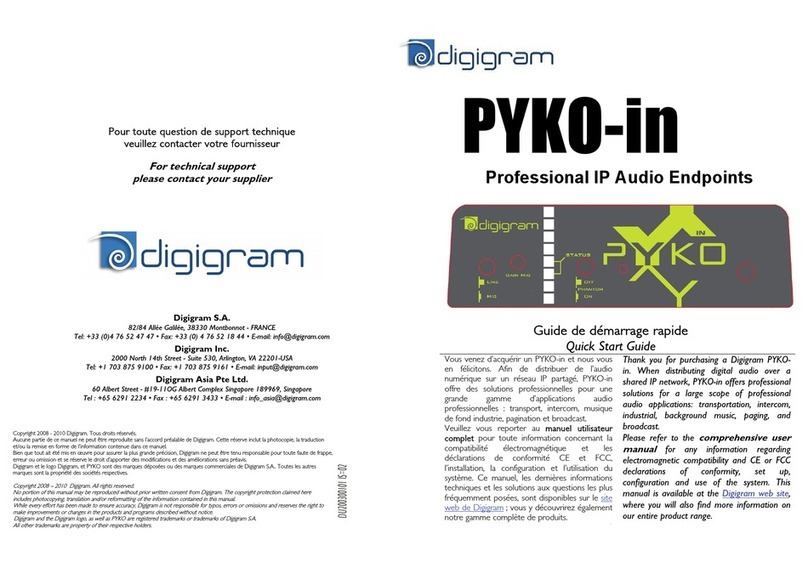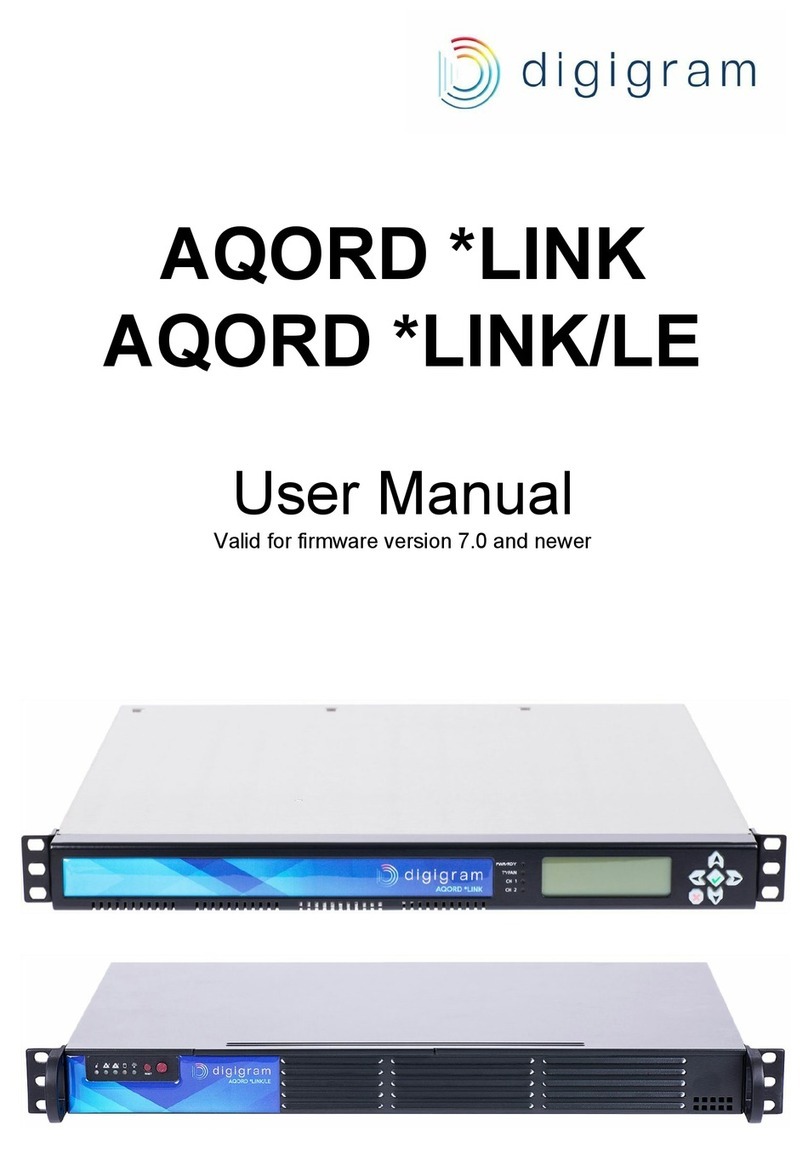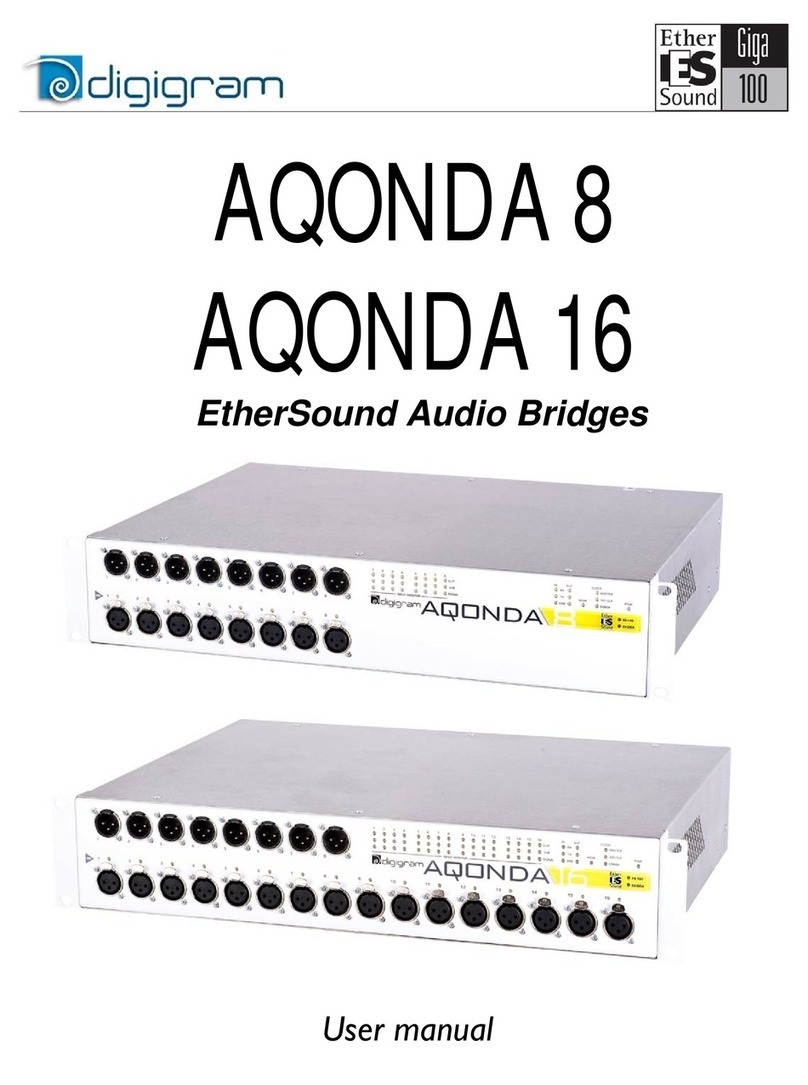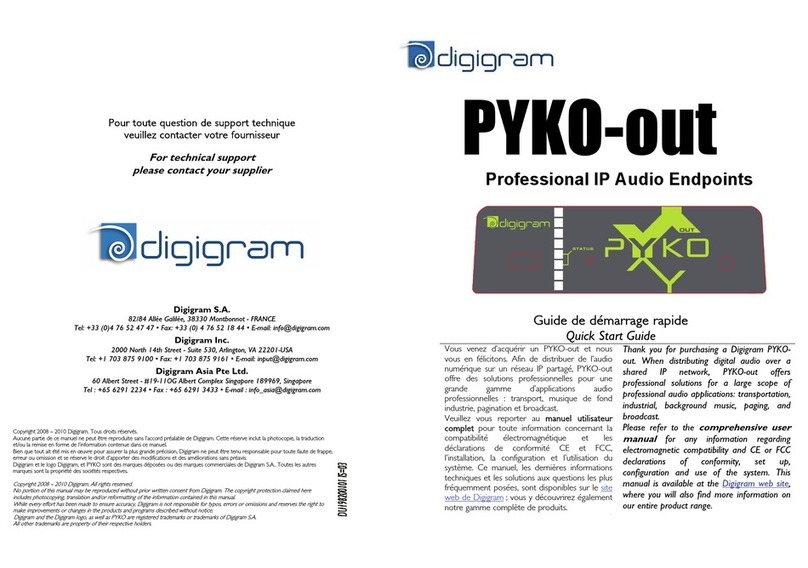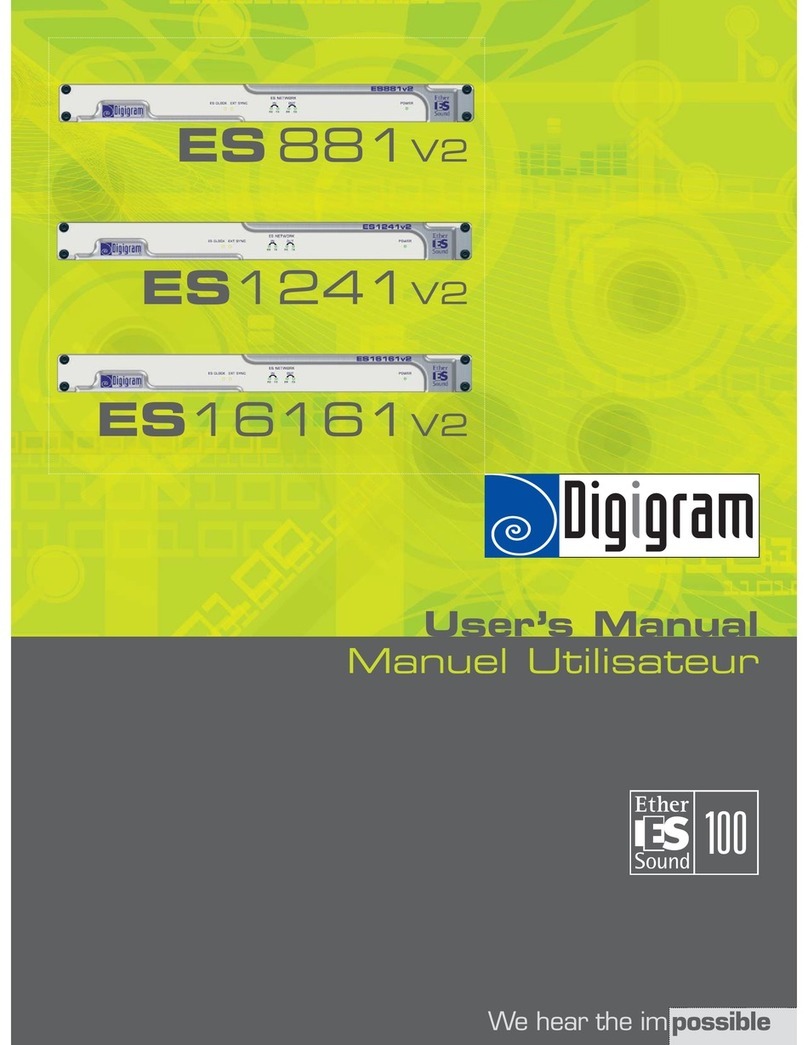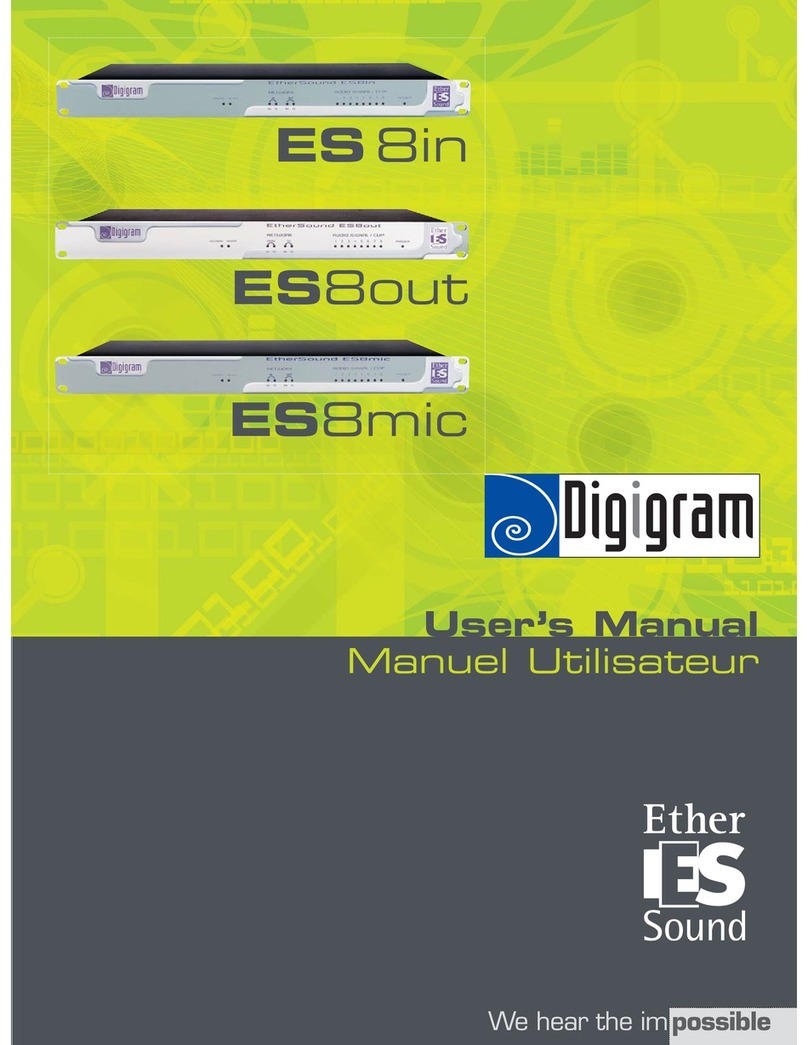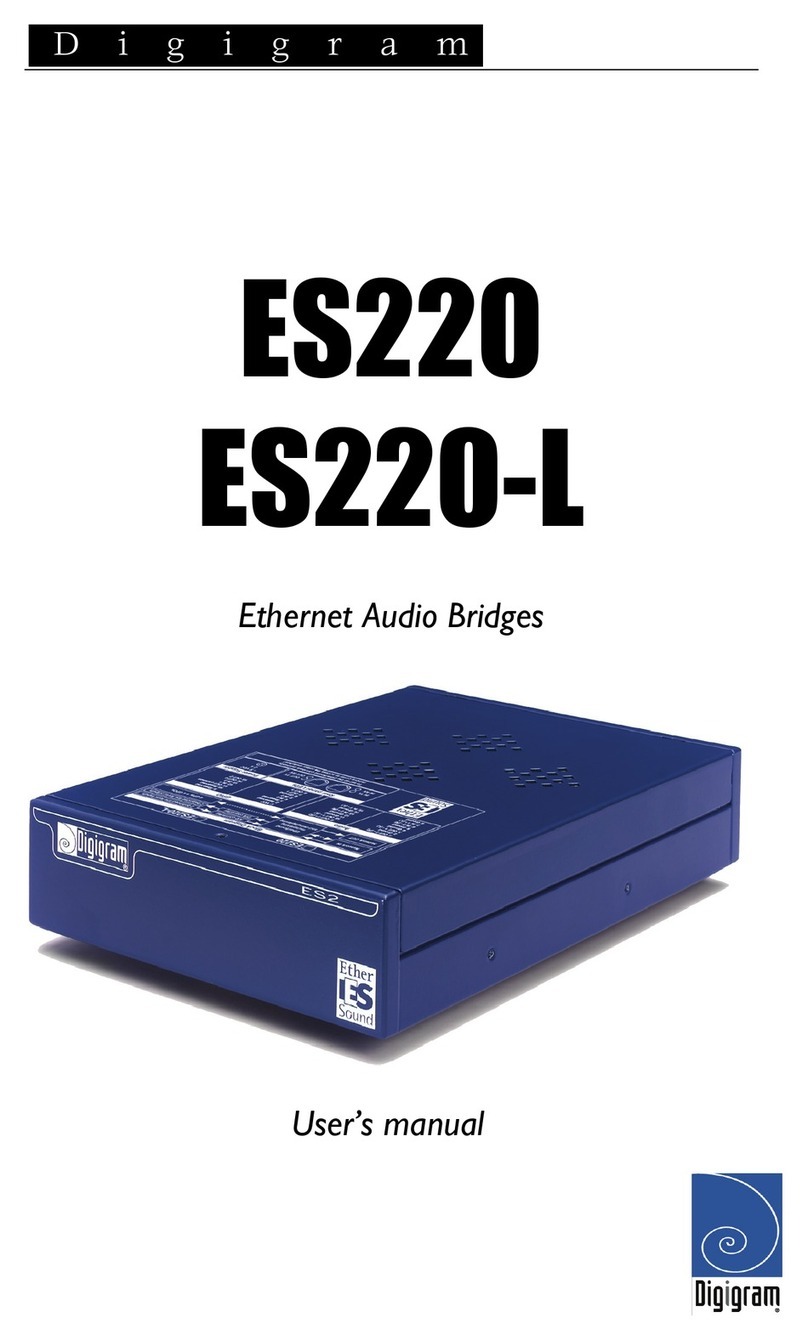
PYKO-in: Professional IP audio endpoint
Important Safety Information
read carefully before using this equipment!
Follow these instructions and keep them in a safe place! Keep in mind that damages due to failure to
observe the instructions contained in this manual are not covered by warranty.
Instructions importantes de sécurité
lire soigneusement avant d’utiliser l’équipement!
Lisez et suivez ces instructions. Conservez les pour consultation ultérieure! Les dommages dus au
non-respect des instructions contenues dans ce manuel ne sont pas couverts par la garantie.
Wichtige Sicherheitshinweise
vor Inbetriebnahme des Gerätes sorgfältig lesen!
Befolgen Sie die Anweisungen und bewahren Sie sie für spätere Fragen auf! Bei Schäden, die durch
Nichtbeachten dieser Bedienungsanleitung verursacht werden, erlischt der Garantieanspruch!
Throughout this manual, the
lightning bolt triangle is used to alert
the user to the risk of electric shock.
The exclamation point triangle is
used to alert the user to important operating or
maintenance instructions.
Do Not Open the Cabinet
There are no user-serviceable components inside
this product. Opening the cabinet may present a
shock hazard, and any modification to the product
will void your warranty. If it is necessary to open the
device for maintenance or advanced configuration
purposes, this is to be done by qualified personnel
only after disconnecting the power cord and network
cables!
Power supply
The device is to be connected only to
a power supply as specified in this
manual and marked on the equipment.
This equipment must be earthed!
Do not block any of the ventilation openings!
Humidity
To reduce the risk of fire or shock, do not expose
this device to rain or moisture. Do not place objects
filled with liquid on this device.
Installation Location
To ensure proper operation and to avoid safety
hazards, the device must be installed in a 19“ rack
mount chassis. The electrical installation of the
building should dispose of easily accessible
disconnecting means in the immediate vicinity of the
device.
If rack installation is not possible, place it on a firm
and level surface. The use of a supply lead with a
power plug respecting the legal standards in the
country of use is obligatory. The plug shall be easily
accessible in case of a problem.
Avoid installation in extremely hot or cold locations,
or in an area that is exposed to direct sunlight or
heating equipment. Avoid moist or humid locations.
Connection of this product to an IT power supply
system is only in Norway.
Cleaning
Clean only with a soft, dry cloth. If necessary, after
disconnecting the unit’s cables, wipe it with a soft
cloth dampened with mild soapy water, then with a
fresh cloth with clean water. Wipe dry immediately
with a dry cloth. NEVER use benzene, aerosol
cleaners, thinner, alcohol or any other volatile
cleaning agent. Do not use abrasive cleaners, which
may damage the finish of metal or other parts.
Refer all servicing to qualified service
personnel.
Servicing is required when the apparatus has been
damaged in any way, such as power supply cord or
plug is damaged, liquid has been spilled, the
apparatus has been exposed to rain or moisture,
does not operate normally, or has been dropped.
Moving the device
Before moving the unit, be certain to disconnect any
cables that connect with other components.
Ne pas ouvrir l’appareil
L’ouverture du coffret peut produire un risque de
choc électrique, et toute modification du produit
annule votre garantie. S’il est nécessaire d’ouvrir
l’appareil pour l’entretien ou la configuration
avancée, cela doit être fait par du personnel
qualifié, après avoir débranché le cordon
d’alimentation et les câbles réseaux !
Alimentation
Il est primordial de connecter l’appareil à une
alimentation électrique telle que spécifiée dans ce
manuel d´utilisateur et sur le matériel même.
Cet équipement doit être raccordé à la terre !
N’obstruer aucune ouverture de ventilation !
Humidité
Afin de réduire les risques de feu ou de choc,
n’exposez pas cet appareil à la pluie ou l’humidité.
Ne placez pas d´objet contenant un liquide sur
l’appareil.
Installation, mise en place
Afin d’assurer le fonctionnement correct et de
minimiser les risques potentiels liés à la sécurité,
l’appareil doit être installé dans un chassis. Prévoir
dans l’installation électrique du bâtiment un
dispositif de sectionnement aisément accessible et
à proximité immédiate de l’appareil.
Si l’installation dans une baie ne vous est pas
possible, placez-le sur une surface solide et plane.
L’utilisation d’un câble d’alimentation avec une fiche
de prise de courant respectant les normes en
vigueur dans le pays d’utilisation est obligatoire. De
plus la fiche de prise de courant doit être aisément
accessible en cas de problème.
Évitez une installation dans des endroits très
chauds ou très froids ainsi que dans des lieux
exposés directement au soleil. Évitez les lieux
présentant un excès d’humidité.
Le raccordement de ce produit à un régime
d’alimentation IT n’est possible qu’en Norvège.
Nettoyage
Nettoyez uniquement avec un chiffon doux et sec.
Si nécessaire, après avoir débranché le cordon
d´alimentation, essuyez-le avec un chiffon doux
humidifié avec de l´eau savonneuse puis rincez le á
l´aide d un chiffon propre et d´eau claire.
Séchez-le immédiatement avec un chiffon sec.
N’utilisez JAMAIS d´essence, de nettoyants en
aérosols, d´alcool ou tout autre agent nettoyant
volatile. N’utilisez pas de produits nettoyants
abrasifs qui pourraient endommager les finitions
métalliques ou d´autres pièces.
Réparation
Lorsque l’appareil a été endommagé quelle qu’en
soit la cause ou qu’il ne fonctionne pas
normalement, toute réparation doit être effectuée
par du personnel qualifié.<0} Avant de transporter
l´unité, assurez-vous d´avoir bien déconnecté le
cordon d’alimentation ainsi que tous les câbles la
reliant à d´autres appareils.
Gerät nicht öffnen
Öffnen des Geräts kann eine Gefährdung durch
Stromschlag und Erlöschen der Garantie zur Folge
haben. Reparaturarbeiten und Änderungen der
Hardwarekonfiguration dürfen nur von qualifiziertem
Personal nach entfernen der Strom- und
Netzwerkkabel durchgeführt werden.
Stromversorgung
Das Gerät darf nur mit der in dieser
Bedienungsanleitung und auf dem
Gerät angegebenen
Stromversorgung betrieben werden.
Erdung ist zu gewährleisten!
Belüftungsschlitze nicht verdecken!
Wasser und Feuchtigkeit
Um Brand- oder Stromschlagrisiken zu vermeiden,
darf das Gerät nicht mit Feuchtigkeit in Berührung
kommen.
Aufbau des Geräts
Um den einwandfreien Betrieb zu gewährleisten
und Sicherheitsrisiken zu vermeiden, sollte das
Gerät in einem 19-Zoll Baugruppenrahmen montiert
werden. Die elektrische Installation des Gebäudes
sollte über einen leicht zugänglichen Trennschalter
in unmittelbarer Nähe des Geräts verfügen Nur
wenn die Installation im Rack nicht möglich ist,
stellen Sie das Gerät auf einen festen,
waagerechten Untergrund.
Die Verwendung eines Anschlußkabels und eines
Steckers, die die im Benutzungsland gültigen
Normen erfüllen, ist obligatorisch. Des weiteren
muß die Steckdose für einen eventuellen
Problemfall leicht zugänglich sein.
Meiden Sie Standorte in der Nähe von Wärme- oder
Feuchtigkeitsquellen sowie direkte
Sonneneinstrahlung.
Anschluß dieses Produktes an eine spezielle
IT-Stromversorgung ist nur in Norwegen genehmigt.
Reinigen des Geräts
Säubern Sie das Gerät nur mit einem weichen,
trockenen Tuch. Bei Bedarf verwenden Sie ein mit
mildem Seifenwasser befeuchtetes Tuch, nachdem
Sie die Netzanschlusskabel aus der Steckdose
gezogen haben, anschließend ein weiches, mit
klarem Wasser befeuchtetes Tuch. Trocken Sie das
Gerät sofort im Anschluß. Keinesfalls Benzol,
Verdünner oder sonstige starke Lösungsmittel oder
Scheuerreiniger verwenden, da hierdurch das
Gehäuse beschädigt werden könnte.
Lassen Sie etwaige Reparaturen nur von
qualifizierten Fachleuten durchführen!
Sollten das Netzkabel oder der Netzstecker
beschädigt sein, oder sollte das Gerät selbst
beschädigt worden sein (z. B. durch Eindringen von
Feuchtigkeit durch Fall auf den Boden), oder sollte
es nicht ordnungsgemäß funktionieren oder eine
deutliche Funktionsabweichung aufweisen, so ist es
von qualifizierten Fachleuten zu reparieren.
